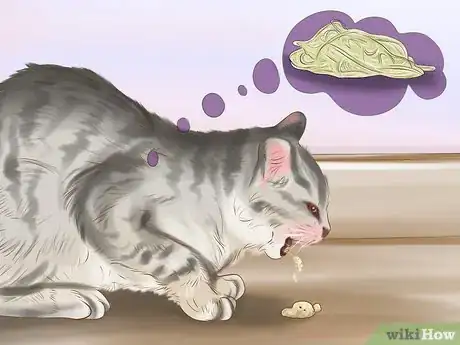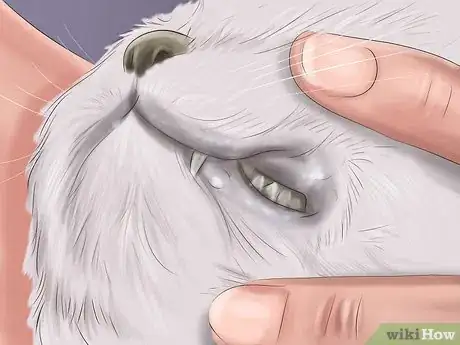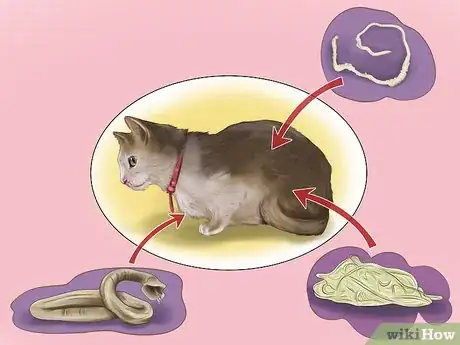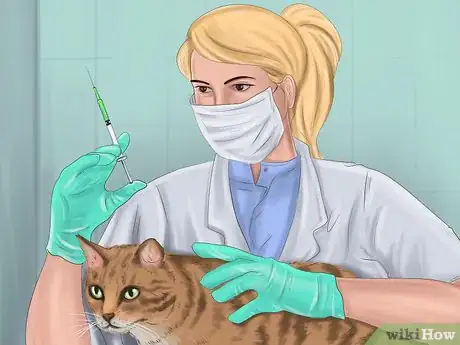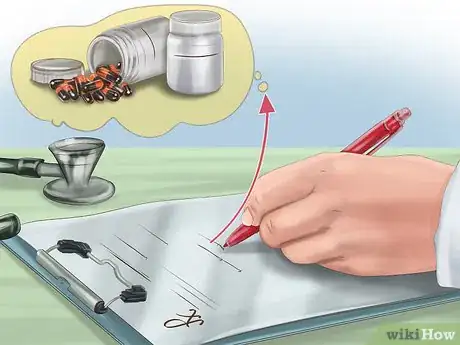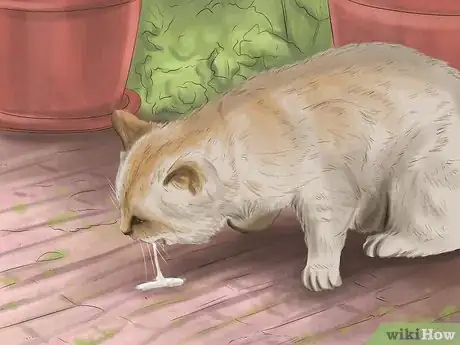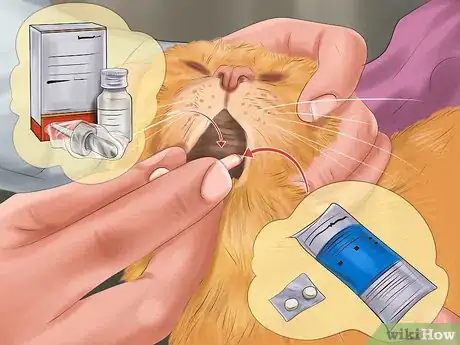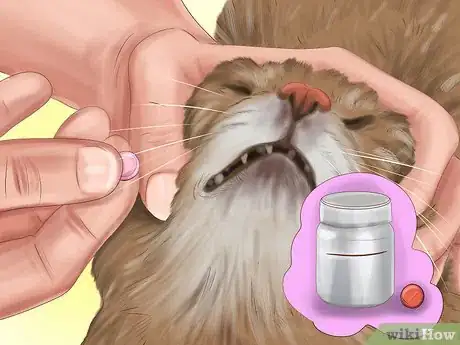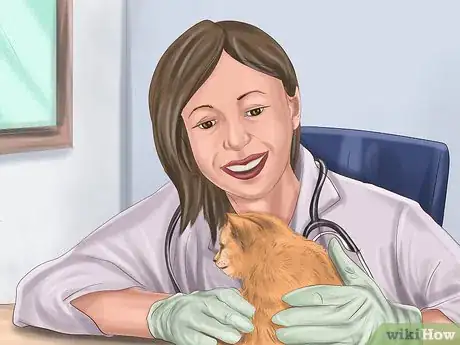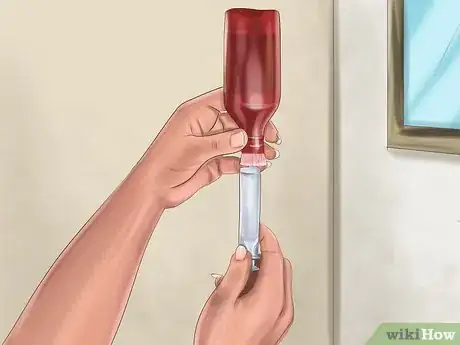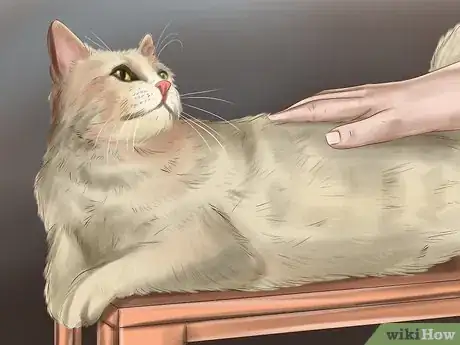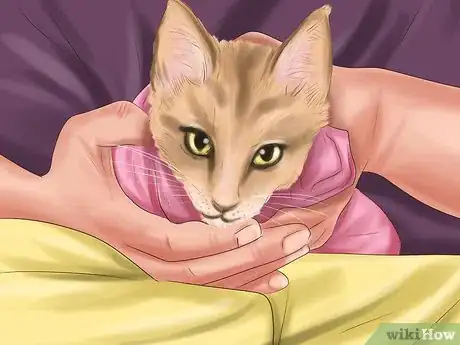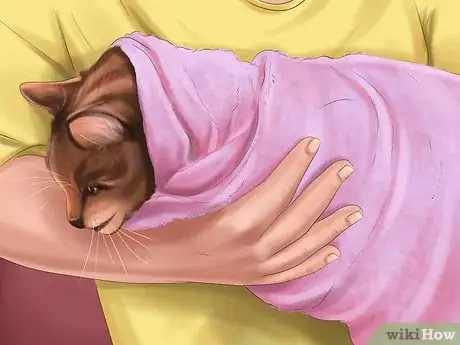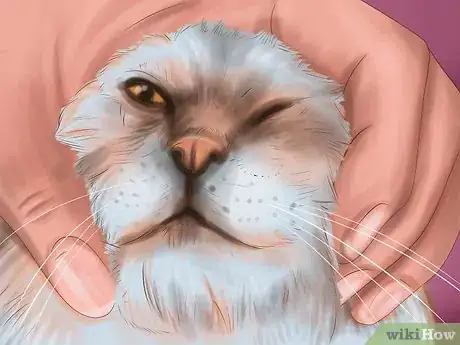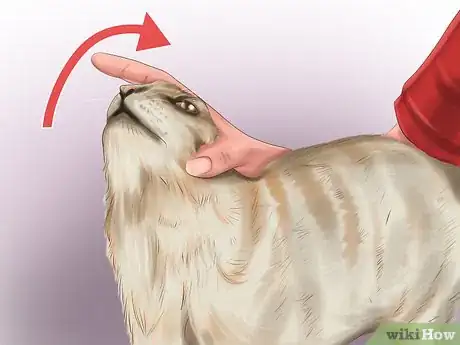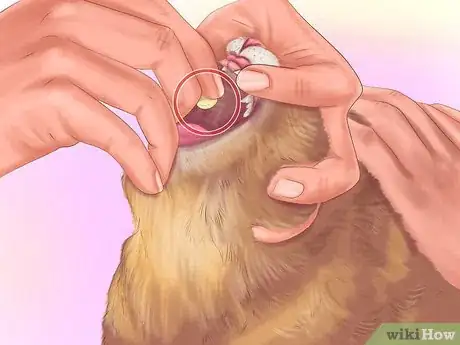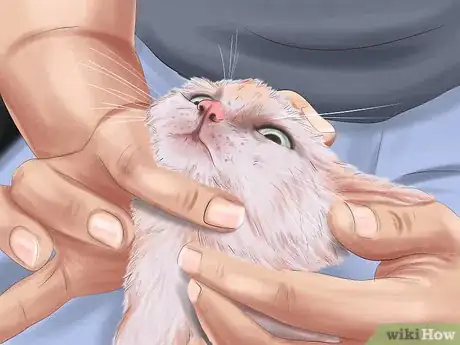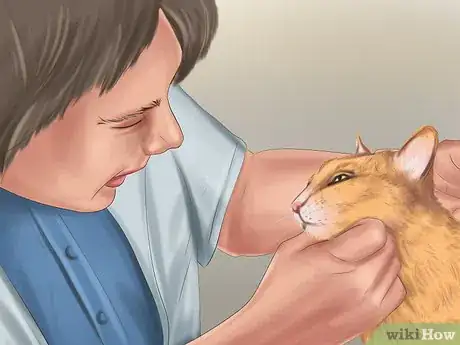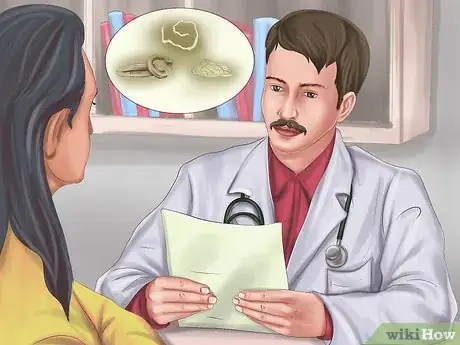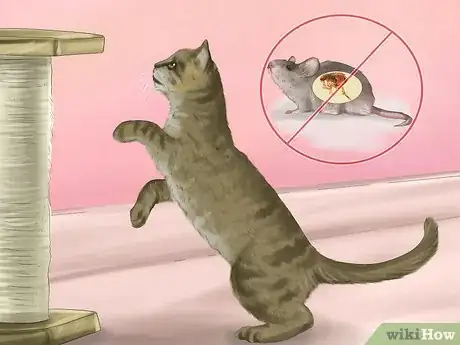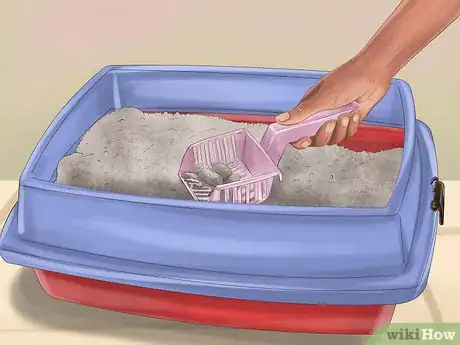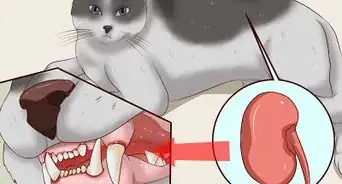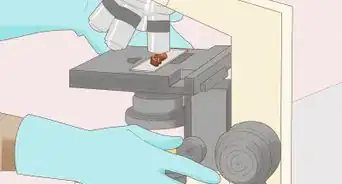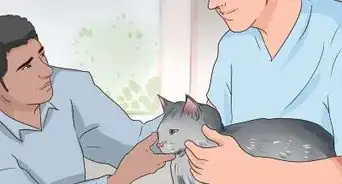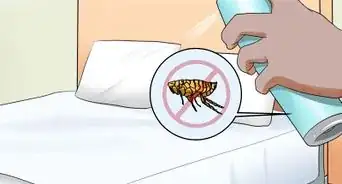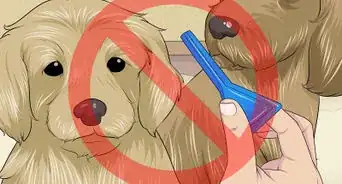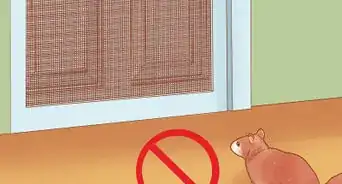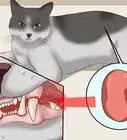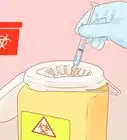This article was co-authored by Pippa Elliott, MRCVS. Dr. Elliott, BVMS, MRCVS is a veterinarian with over 30 years of experience in veterinary surgery and companion animal practice. She graduated from the University of Glasgow in 1987 with a degree in veterinary medicine and surgery. She has worked at the same animal clinic in her hometown for over 20 years.
There are 18 references cited in this article, which can be found at the bottom of the page.
wikiHow marks an article as reader-approved once it receives enough positive feedback. This article received 26 testimonials and 86% of readers who voted found it helpful, earning it our reader-approved status.
This article has been viewed 545,152 times.
Several types of worms can infect cats. The four most common are roundworms, hookworms, tapeworms, and heartworms. Not only do these worms pose a danger to your cat, but some of them can also infect humans and all of them can infect other household pets, so in addition to deworming kittens, recently adopted cats, and cats with symptoms, all cat owners should discuss a regular program of parasite testing and control with their veterinarians. Knowing when to deworm a cat is as important as knowing how to deworm it.
Steps
Diagnosing Your Cat's Worms
-
1Check the fecal matter. The most common sign of worms is actual worms. Look at your cat’s stool for them. Tapeworm segments often break off and come out in your cat's feces. These segments look like little rice grains. When fresh, they may even move like little worms.
- Look for diarrhea. A number of issues can cause diarrhea in cats, but all intestinal worms, including roundworms, hookworms, and tapeworms could potentially cause runny fecal matter. In other instances, your cat may develop blood from colon and intestinal irritation.
- Take a bag and collect these worms for your vet to examine.[1]
-
2Look out for vomiting. Roundworms can cause vomiting in cats. Cats may even vomit up adult roundworms. They’ll look like spaghetti noodles. Vomiting is also a potential symptom of heartworms. Like with their fecal matter, you should try to collect it into a small bag. Your vet will want to examine their throw up for parasites or signs of other conditions.[2] Remember that vomiting is not an automatic sign of worms. It could be any number of issues.Advertisement
-
3Keep track of their weight. Cats with intestinal worms or heartworms may experience weight loss. Sometimes, the change may be drastic and other times it might be marginal.[3] It all depends on the size and quantity of the worms. In other cases, your cat may develop an extended stomach — often called a “pot-belly”. If your cat’s belly has become rounded, it may be suffering from roundworms.
-
4Check your cat’s gums. Normally, a cat’s gums should be pink. Parasites, like many worms cause gums to turn pale through anemia or sheer shock. If you cat has pale gums, schedule a vet appointment. If your cat has difficulty breathing or is lethargic, seek emergency assistance.
-
5Learn what type of worms your cat has. It's important to know the kind of worms your cat has so that you can begin treatment. Your vet will be able to tell you this and prescribe medication and treatment accordingly. Though you don't really need to understand the intricacies of each type of worm, here are the main worms you'll be dealing with:
- Roundworms are the most common parasites in cats. Nursing kittens can get them from a mother's milk while adult cats can get them from infected feces.
- Tapeworms are segmented parasites that can often be seen around the fur of a cat's hind quarters. They can be acquired from ingesting fleas.[4]
- Hookworms are smaller than roundworms and reside in the small intestine. A cat can be infected from skin contact or ingestion. They are more common in dogs.
- Lungworms reside in a cat's lungs and are a less common parasite. They can be acquired through ingestion of a host, such as a bird or a rodent.[5]
- Heartworms are possibly the most dangerous of all. Mosquitoes bite infected animals, taking little heartworm larvae in with their blood meal. The larvae grow and the next time a mosquito bites into an animal (like your cat), it injects the heartworms into the bloodstream.[6]
-
6Take your cat to the vet. Do not think that you can cure your cat on your own — you'll need to take your cat to the vet, who will check your cat's stool sample and confirm the presence of worms. If you can, try to collect a stool sample ahead of time for this test. If your vet suspects heartworm disease, they may take a routine blood sample.[7] There are many different types of worms and the treatment for one will not work for another, so it's important to know exactly what you're dealing with before you begin a course of treatment.
- Typically, deworming medication should be administered bi-weekly or monthly. The treatment is not a one-time deal.
- You may see some web sites that tell you that you can treat your cat "naturally" at home with some herbs and spices. Ignore this kind of information and take your pet to an animal health care professional.[8]
- Take newly-adopted or newly-born kittens to the vet for deworming. This is a routine procedure, whether or not you think that your cat actually has worms. Kittens should be dewormed every 2 weeks from 6 weeks of age until 3 months, and then monthly until they are 6 months old. Adopted kittens should be dewormed immediately, with at least 2 additional treatments two-weeks apart each. Mothers can also pass worms on to their kittens.
Treating Your Cat for Worms
-
1Give your cat their prescription. Obtain the necessary medication from your veterinarian. You should never try to medicate with over-the-counter dewormers without checking first with your veterinarian, especially with kittens. Though it's most likely that your cat will be given a series of pills, other medications can come in the forms of tablets, capsules, granules, chewables, liquids, and topical treatments.[9]
- Do not try to choose the medication yourself; listen to your vet’s instructions for both how and how often the medication should be administered. Once you know what medication you should give your cat and how often you should administer it, it's important to follow the entire course of treatment that has been recommended by your veterinarian. Whether it is oral or topical, you must administer the medication to your kitty for the entire course of the treatment.
-
2Be prepared for side effects. The important thing is that they are more poisonous to the parasites (the worms) than they are to the host (your kitty). This is why it's important to get help from a vet and to give your cat medication exactly as you're instructed to do. Some side effects include diarrhea and vomiting. Talk to your vet about what is and is not expected as a side effect from this medication, and make sure that your cat is reacting appropriately.[10]
-
3Treat roundworms and hookworms. The most common medication for roundworms and hookworms in adult cats include pyrantel pamoate, milbemycin oxime, and selamectin. Pyrantel pamoate and milbemycin oxime are oral medications and selamectin is a topical medication.[11] In the United States, pyrantel pamoate is available over the counter, and selamectin and milbemycin oxime are available only with a prescription. Selamectin is not appropriate for use in kittens under 8 weeks of age, so young kittens are wormed with oral wormers.[12]
-
4Tackle tapeworms. The two medications most commonly used to treat tapeworms are praziquantel and epsiprantel. Both are oral medications. Praziquantel is available over the counter, and epsiprantel requires a prescription.
- Generally, your veterinarian will want to perform another fecal test after treatment to make sure the medication has done its job. Be sure to follow your veterinarian's instructions about giving the wormer and scheduling rechecks to make sure the treatment is effective.[13]
-
5Go in for a check-up. Your vet will tell you when the next time you should come back will be. Make sure to follow directions and to bring back your kitty, whether it's for another round of treatment or just to confirm that the worm problem has been solved. It's important to visit your vet when you have been told to visit so that you can make sure your kitty is healthy and happy.
Giving Your Cat Oral Medication
-
1Prepare the medication. Shake up the bottle if necessary or take the pills out of the bottle. You may have to place a liquid medication into an oral syringe or eye dropper. Your vet will let you know what is the ideal delivery system.[14]
- Keep it out of your cat’s sight. Your cat may spot the pill or liquid medication bottle and preemptively run away. Sometimes, it's a good idea to prepare the medications and then wait several minutes for your cat to calmly return to you so that you can safely handle him or her.
-
2Keep your kitty calm. Once you have been given the prescribed treatment for your cat's worms, you will need to know how to administer it. It can get a bit tricky to give a cat oral medication, but it can be done well as long as you keep your kitty calm and happy. If you are told to administer the medication at home, you'll need to know how to calm your cat down to give him the medicine he needs.
-
3Bundle your cat up. Wrap your cat in a small blanket, pillowcase, or towel with only its head exposed. This will keep your cat from scratching or fighting you. However, make sure your cat doesn't feel too scared or suffocated when you do this. You can also try to administer the medication without bundling your cat up. This may ease your cat's anxiety, but it will make your cat harder to manage.[15]
-
4Hold the cat securely. Sit on the floor and place your cat between your legs or on your lap. You can also have someone hold your cat for you. Having another person helping you out can make the process a lot easier.[16]
-
5Hold your cat’s head properly. Place your thumb on one side and your forefinger on the other side of your cat's mouth. Be careful; your cat may try to bite you here, but this comes with the territory.[17]
-
6Tilt your cat’s head back. While doing this, apply pressure gently on the sides of your cat’s mouth until its mouth opens. Try to be as calm as possible when you do this. If you're anxious, then your cat will sense your anxiety and will also be more worried than necessary. You should press down with the other hand on your cat's lower jaw, thus opening its mouth further.[18]
-
7Place the medication in your cat's mouth. Place the pill in the back of the mouth or squeeze liquid medication in the side of one cheek. Be careful to not put the medication down your cat's throat to avoid choking.[19]
-
8Help your cat swallow the medication. Here's what you need to do to help your cat swallow the medication most effectively:
- Let your cat close its mouth.
- Lift your cat's jaw so that its nose points upward.
- Rub your cat's throat gently to trigger the swallowing reflex.
- Maintain the same position for a few seconds or until your cat has swallowed. Be gentle throughout this process. You don’t want your cat to choke on the medicine.[20]
-
9Make sure the medication has been swallowed. Release its mouth, but hold onto your cat in case it did not swallow the medication and spits it out. Release your cat only when you are sure that the medication has been swallowed.[21]
- Spitting out medication is primarily a problem with capsule medication. Liquid medications are more difficult for cats to spit out.
-
10Praise your cat for a job well done. Remove the blankets or covers and praise your cat for his or her good behavior. Give your cat treats, attention, and a lot of love for doing so well. This will make the process easier the next time. Your cat should associate it with something good, not something scary. It'll fight harder in the future to get away, if it has a bad experience with the medicine or the process.
Preventing Worms in the Future
-
1Give your cat regular parasite preventative medication. Consult your vet for specifics. Some medications, such as selamectin, act broadly to protect against fleas, heartworms, hookworms, roundworms, and other parasites.[22]
-
2Consider keeping your cats indoors. Since other infected cats, fleas, or rodents carry parasites, keeping your cat indoors will reduce their opportunities to contract worms. Many cat owners feel guilty for keeping their cats indoors. They feel like they are depriving their cats in some way. "Shouldn’t my cat be able to express their natural instincts in the fresh air and sunshine?" This question guides their decision. In order to make this decision properly, you should weigh the pros and cons.
- Are the risks too great? Consider road conditions, disease factors, environmental issues, other animals, and other human beings when you make your decision. If you decide to keep your cat indoors to avoid such risks, remember that you can closely replicate the outdoors with scratching posts, windows, and fun things to climb on.[23]
-
3Keep fleas out of your home and yard. In general, if your cat stays indoors, then you don’t need to worry about outdoor spaces. Cats are fairly well-adept at killing off fleas especially if they are not inundated with them constantly. So focus on where they spend most of their time.
- Home: Your primary tactic in the war against fleas should be sanitation. Wash all of your cat’s favorite pillows, blankets, and anything else they tend to lay on frequently. You want to wash away fleas, their eggs, and their pupae or young fleas. Thoroughly vacuum your carpet to do the same. If your case is moderate to extreme, consider using a fogger. Make sure you choose a brand that kills fleas and flea eggs. During use, humans and all animals need to clear out of the home for the time indicated on the can. Afterwards, wipe down all surfaces and vacuum again to remove dead fleas/flea eggs as well as leftover toxins.[24]
- Yard: Flea control outdoors is much harder. Start by cleaning up organic debris that might harbor fleas like grass clippings, leaves, and straw. Fleas like to hide in dark, moist, and shady areas. Purchase an environmentally safe spray and douse these areas according to the instructions indicated on the product.[25]
-
4Frequently clean your cat's litter box. Remove feces on a regular basis to stop worms from spreading. Wear disposable plastic gloves and possibly a face mask. You don’t want to breathe in your cat’s fecal dust. Scoop all the litter into a garbage bag. Use paper towels and some natural antibacterial spray to wipe out the inside of the litter box. Consider even washing the litter box out thoroughly with soapy water. Then replace with clean litter. Do this once or twice a week depending on your cat’s litter box use.[26]
Expert Q&A
-
QuestionIf my cat vomited up her deworming tablet, should I repeat the dose?
 Pippa Elliott, MRCVSDr. Elliott, BVMS, MRCVS is a veterinarian with over 30 years of experience in veterinary surgery and companion animal practice. She graduated from the University of Glasgow in 1987 with a degree in veterinary medicine and surgery. She has worked at the same animal clinic in her hometown for over 20 years.
Pippa Elliott, MRCVSDr. Elliott, BVMS, MRCVS is a veterinarian with over 30 years of experience in veterinary surgery and companion animal practice. She graduated from the University of Glasgow in 1987 with a degree in veterinary medicine and surgery. She has worked at the same animal clinic in her hometown for over 20 years.
Veterinarian If she was sick within a couple of hours, then yes, leave it a day or so and then repeat the dose. If the tablet was in her stomach for longer than 2 hours, then she may well have absorbed a good percentage of the active ingredient, so just wait until she's next due for worming.
If she was sick within a couple of hours, then yes, leave it a day or so and then repeat the dose. If the tablet was in her stomach for longer than 2 hours, then she may well have absorbed a good percentage of the active ingredient, so just wait until she's next due for worming. -
QuestionIs it OK to deworm a cat that has an URI?
 Pippa Elliott, MRCVSDr. Elliott, BVMS, MRCVS is a veterinarian with over 30 years of experience in veterinary surgery and companion animal practice. She graduated from the University of Glasgow in 1987 with a degree in veterinary medicine and surgery. She has worked at the same animal clinic in her hometown for over 20 years.
Pippa Elliott, MRCVSDr. Elliott, BVMS, MRCVS is a veterinarian with over 30 years of experience in veterinary surgery and companion animal practice. She graduated from the University of Glasgow in 1987 with a degree in veterinary medicine and surgery. She has worked at the same animal clinic in her hometown for over 20 years.
Veterinarian Yes, indeed it can be a good idea as getting rids of worms could boost the immune system. Just be careful how you give the dewormer, especially if the cat has trouble breathing. Also, if the cat is on treatment, check first with the vet to make sure there are no drug interactions.
Yes, indeed it can be a good idea as getting rids of worms could boost the immune system. Just be careful how you give the dewormer, especially if the cat has trouble breathing. Also, if the cat is on treatment, check first with the vet to make sure there are no drug interactions. -
QuestionCan I use Mebex to deworm my cat?
 Pippa Elliott, MRCVSDr. Elliott, BVMS, MRCVS is a veterinarian with over 30 years of experience in veterinary surgery and companion animal practice. She graduated from the University of Glasgow in 1987 with a degree in veterinary medicine and surgery. She has worked at the same animal clinic in her hometown for over 20 years.
Pippa Elliott, MRCVSDr. Elliott, BVMS, MRCVS is a veterinarian with over 30 years of experience in veterinary surgery and companion animal practice. She graduated from the University of Glasgow in 1987 with a degree in veterinary medicine and surgery. She has worked at the same animal clinic in her hometown for over 20 years.
Veterinarian Mebex is a human deworming medication that contains mebendazole. This drug is suitable for use in cats, but it isn't licensed for use in this species. This means the law requires you to use a veterinary-approved product first. There are plenty of effective alternatives for use in cats that are licensed, so this would be a better option.
Mebex is a human deworming medication that contains mebendazole. This drug is suitable for use in cats, but it isn't licensed for use in this species. This means the law requires you to use a veterinary-approved product first. There are plenty of effective alternatives for use in cats that are licensed, so this would be a better option.
Things You'll Need
- Cat
- Blanket, pillowcase or towel
- Medication
- Cat treats
References
- ↑ http://www.ivis.org/advances/Parasit_Bowman/ddb_GI/chapter.asp?LA=1#Dipylidium_caninum
- ↑ https://www.heartwormsociety.org/heartworms-in-cats
- ↑ http://www.cat-world.com.au/weight-loss-in-cats
- ↑ http://www.icatcare.org/advice/keeping-your-cat-healthy/worms-and-worming-your-cat
- ↑ http://www.aspca.org/pet-care/cat-care/worms
- ↑ https://www.heartwormsociety.org/pet-owner-resources/heartworm-basics
- ↑ https://heartwormsociety.org/images/pdf/Feline-Guidelines-Summary.pdf
- ↑ http://pets.webmd.com/cats/worms-cats-infection-intestinal-parasites?page=2
- ↑ http://www.drsfostersmith.com/pic/article.cfm?aid=1085
- ↑ http://pets.webmd.com/cats/deworming-cat
- ↑ http://www.merckvetmanual.com/mvm/digestive_system/gastrointestinal_parasites_of_small_animals/roundworms_in_small_animals.html
- ↑ http://www.drugs.com/vet/revolution.html
- ↑ http://www.merckvetmanual.com/mvm/digestive_system/gastrointestinal_parasites_of_small_animals/roundworms_in_small_animals.html
- ↑ http://www.peteducation.com/article.cfm?c=21+1276&aid=1062
- ↑ http://www.peteducation.com/article.cfm?c=21+1276&aid=1062
- ↑ http://www.vetmed.wsu.edu/ClientED/cat_meds.aspx
- ↑ http://www.vetmed.wsu.edu/ClientED/cat_meds.aspx
- ↑ http://www.vetmed.wsu.edu/ClientED/cat_meds.aspx
- ↑ http://www.vetmed.wsu.edu/ClientED/cat_meds.aspx
- ↑ http://www.vetmed.wsu.edu/ClientED/cat_meds.aspx
- ↑ http://www.vetmed.wsu.edu/ClientED/cat_meds.aspx
- ↑ https://www.heartwormsociety.org/images/pdf/2014-AHS-Feline-Guidelines.pdf
- ↑ http://www.americanhumane.org/animals/adoption-pet-care/caring-for-your-pet/indoor-cats-vs-outdoor-cats.html
- ↑ https://www.aspca.org/pet-care/cat-care/fleas
- ↑ https://www.aspca.org/pet-care/cat-care/fleas
- ↑ http://petcaretips.net/how-clean-cat-litter-box.html
About This Article
If you think your cat has worms, take it to the vet to get it the medication it needs. Bring a sample of your cat's stool with you in a plastic bag if you've noticed worms in it so the vet can identify what kind of worms your cat has. The vet will examine your cat and perhaps run a few tests to figure out the type of worms and what medication would be best. They'll likely administer the first dose of a deworming medication in the office. You may need to administer the second dose yourself 1-3 months after the first dose. If you can't take your cat to a vet, you can try purchasing general deworming pills online or at a local pet store. Remember to follow the instructions on the label to determine how many pills your cat needs. If your cat won't take the pill, try hiding it in its food or in a treat. For more tips from our Veterinary co-author, like how to prevent your cat from getting worms in the future, read on!

